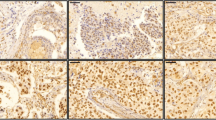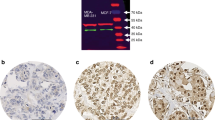Abstract
Purpose
Retinoic acid-induced 2 (RAI2) has been shown to be a putative suppressor of the early hematogenous dissemination of tumor cells to the bone marrow in breast cancer. Here, we investigated the associations of RAI2 mRNA and protein expression with clinicopathological factors and prognosis in breast cancer patients with long-term follow-up.
Methods
Invasive breast cancer tissues (n = 604) were analyzed for RAI2 mRNA expression. We examined the associations of clinicopathological factors with the expression levels of RAI2 mRNA in these samples. We also analyzed RAI2 protein expression by immunohistochemistry in invasive breast cancer tissues (n = 422).
Results
We identified significant positive associations between low expression of RAI2 mRNA and shorter disease-free survival (DFS), breast-cancer-specific survival (BCSS), and overall survival (OS) in breast cancer patients. We also identified significant positive associations between negative for RAI2 protein expression and shorter DFS, BCSS, and OS in breast cancer patients. Low RAI2 mRNA and negative for RAI2 protein expression were positively associated with larger tumor size, higher tumor grade, and ERα-negativity. Multivariate analyses indicated that not only RAI2 mRNA but also RAI2 protein expression were independent risk factors for both DFS and BCSS in breast cancer patients. The median follow-up periods were 10.3 and 9.3 years for the RAI2 mRNA and protein expression analyses, respectively.
Conclusions
Our findings suggest that RAI2 has a role in the metastasis of breast cancer, and that RAI2 expression could be a promising candidate biomarker of prognosis in breast cancer patients.









Similar content being viewed by others
References
Kang Y, Pantel K (2013) Tumor cell dissemination: emerging biological insights from animal models and cancer patients. Cancer Cell 23(5):573–581. https://doi.org/10.1016/j.ccr.2013.04.017
Lin H, Balic M, Zheng S, Datar R, Cote RJ (2011) Disseminated and circulating tumor cells: role in effective cancer management. Crit Rev Oncol Hematol 77(1):1–11. https://doi.org/10.1016/j.critrevonc.2010.04.008
Riethdorf S, Pantel K (2008) Disseminated tumor cells in bone marrow and circulating tumor cells in blood of breast cancer patients: current state of detection and characterization. Pathobiology 75(2):140–148. https://doi.org/10.1159/000123852
Wikman H, Vessella R, Pantel K (2008) Cancer micrometastasis and tumour dormancy. APMIS 116(7–8):754–770. https://doi.org/10.1111/j.1600-0463.2008.01033.x
Werner S, Brors B, Eick J, Marques E, Pogenberg V, Parret A, Kemming D, Wood AW, Edgren H, Neubauer H, Streichert T, Riethdorf S, Bedi U, Baccelli I, Jucker M, Eils R, Fehm T, Trumpp A, Johnsen SA, Klefstrom J, Wilmanns M, Muller V, Pantel K, Wikman H (2015) Suppression of early hematogenous dissemination of human breast cancer cells to bone marrow by retinoic acid-induced 2. Cancer Discov 5(5):506–519. https://doi.org/10.1158/2159-8290.CD-14-1042
Jonk LJ, de Jonge ME, Vervaart JM, Wissink S, Kruijer W (1994) Isolation and developmental expression of retinoic-acid-induced genes. Dev Biol 161(2):604–614. https://doi.org/10.1006/dbio.1994.1056
Walpole SM, Hiriyana KT, Nicolaou A, Bingham EL, Durham J, Vaudin M, Ross MT, Yates JR, Sieving PA, Trump D (1999) Identification and characterization of the human homologue (RAI2) of a mouse retinoic acid-induced gene in Xp22. Genomics 55(3):275–283. https://doi.org/10.1006/geno.1998.5667
Liao HM, Niu DM, Chen YJ, Fang JS, Chen SJ, Chen CH (2011) Identification of a microdeletion at Xp22.13 in a Taiwanese family presenting with Nance-Horan syndrome. J Hum Genet 56(1):8–11. https://doi.org/10.1038/jhg.2010.121
Elston CW, Ellis IO (1991) Pathological prognostic factors in breast cancer. I. The value of histological grade in breast cancer: experience from a large study with long-term follow-up. Histopathology 19(5):403–410. https://doi.org/10.1111/j.1365-2559.1991.tb00229.x
McShane LM, Altman DG, Sauerbrei W, Taube SE, Gion M, Clark GM, Statistics Subcommittee of the NCIEWGoCD (2005) REporting recommendations for tumour MARKer prognostic studies (REMARK). Br J Cancer 93(4):387–391. https://doi.org/10.1038/sj.bjc.6602678
Yan W, Wu K, Herman JG, Xu X, Yang Y, Dai G, Guo M (2018) Retinoic acid-induced 2 (RAI2) is a novel tumor suppressor, and promoter region methylation of RAI2 is a poor prognostic marker in colorectal cancer. Clin Epigenet 10:69. https://doi.org/10.1186/s13148-018-0501-4
Esposito M, Kang Y (2015) RAI2: linking retinoic acid signaling with metastasis suppression. Cancer Discov 5(5):466–468. https://doi.org/10.1158/2159-8290.CD-15-0352
Acknowledgements
We are grateful to the patients in this study. We thank Mrs. Makino and Ms. Ueki for excellent technical assistance. We also thank H. Nikki March, PhD, from Edanz Group (https://en-author-services.edanz.com/ac) for editing a draft of this manuscript.
Funding
This work was supported by a Grant-in-Aid for Scientific Research from the Ministry of Education, Culture, Sports, Science, and Technology of Japan (MEXT) KAKENHI Grant Number 16K10468.
Author information
Authors and Affiliations
Corresponding author
Ethics declarations
Conflict of interest
The authors declare that they have no conflict of interest.
Ethical approval
This study was approved by the Institutional Review Board of Nagoya City University Graduate School of Medical Sciences. All tissue samples were provided by a biobank that is maintained by the Department of Breast Surgery, Nagoya City University Graduate School of Medical Sciences, which conforms to the guidelines of the Declaration of Helsinki.
Informed consent
Written informed consent for the comprehensive research use of clinical samples was obtained from all patients involved in this study.
Additional information
Publisher's Note
Springer Nature remains neutral with regard to jurisdictional claims in published maps and institutional affiliations.
Rights and permissions
About this article
Cite this article
Nishikawa, S., Uemoto, Y., Kim, TS. et al. Low RAI2 expression is a marker of poor prognosis in breast cancer. Breast Cancer Res Treat 187, 81–93 (2021). https://doi.org/10.1007/s10549-021-06176-w
Received:
Accepted:
Published:
Issue Date:
DOI: https://doi.org/10.1007/s10549-021-06176-w




